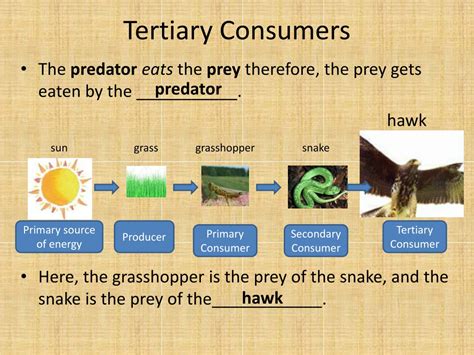The concept of a tertiary consumer is a fundamental aspect of ecology, specifically within the realm of food webs and trophic levels. In essence, a tertiary consumer, also known as a third-level consumer or apex predator, occupies the highest trophic level in a food chain. These organisms primarily feed on secondary consumers, which in turn consume primary consumers that directly feed on producers (plants and other autotrophic organisms). The role of tertiary consumers is crucial as they regulate the populations of the species below them in the food chain, maintaining the balance of the ecosystem.
Understanding Tertiary Consumers in Ecosystems

Tertiary consumers are characterized by their position at the apex of the food chain, with no natural predators within their environment. Examples include lions in savannas, polar bears in the Arctic, and sharks in marine ecosystems. These organisms are vital for maintaining the structure of their respective ecosystems. By preying on secondary consumers, they prevent any one species from overpopulating and depleting the resources available to other species in the ecosystem. This regulatory function is essential for the biodiversity and health of the ecosystem.
Ecological Role and Impact
The ecological role of tertiary consumers extends beyond population regulation. They also influence the behavior and evolution of the species they prey upon. For instance, the presence of a tertiary consumer can lead to changes in the migratory patterns, habitat selection, and even the physical characteristics of its prey, as these species adapt to minimize their vulnerability to predation. Moreover, the loss of a tertiary consumer from an ecosystem can have cascading effects, leading to changes in population sizes of species at lower trophic levels, a phenomenon known as a trophic cascade.
| Trophic Level | Example Organisms | Role in Ecosystem |
|---|---|---|
| Producers | Plants, Algae | Base of the food web, convert sunlight into energy |
| Primary Consumers | Herbivores (Deer, Insects) | Feed on producers, energy transfer to next level |
| Secondary Consumers | Omnivores/Carnivores (Frogs, Small Mammals) | Feed on primary consumers, further energy transfer |
| Tertiary Consumers | APEX Predators (Lions, Sharks, Polar Bears) | Regulate ecosystem balance, prey on secondary consumers |

Key Points
- Tertiary consumers are at the top of the food chain and play a crucial role in maintaining ecosystem balance.
- They primarily feed on secondary consumers, regulating their populations and preventing overgrazing or overbrowsing of plant species.
- The presence of tertiary consumers influences the behavior, evolution, and population dynamics of species at lower trophic levels.
- The loss of a tertiary consumer can lead to trophic cascades, significantly altering the ecosystem's structure and function.
- Conservation of tertiary consumers and their habitats is essential for preserving biodiversity and ecological integrity.
Challenges Facing Tertiary Consumers

Tertiary consumers face numerous challenges, including habitat loss, climate change, pollution, and hunting. These pressures can lead to population declines, making ecosystems more vulnerable to disruption. For example, the reduction in shark populations due to overfishing can lead to an increase in the populations of their prey species, potentially depleting fish stocks and affecting commercial fisheries.
Conservation Efforts
Conservation efforts aimed at protecting tertiary consumers and their habitats are critical. This includes the establishment of protected areas, regulation of hunting and fishing practices, and initiatives to reduce pollution and mitigate the effects of climate change. Additionally, educating the public about the importance of these apex predators and the role they play in maintaining healthy ecosystems can garner support for conservation initiatives.
What is the primary role of tertiary consumers in an ecosystem?
+Tertiary consumers primarily regulate the populations of secondary consumers, maintaining the balance of the ecosystem and preventing any one species from dominating and potentially depleting resources.
Why are tertiary consumers important for biodiversity?
+Tertiary consumers are important for biodiversity because they regulate the populations of species at lower trophic levels, ensuring that no single species overpopulates and outcompetes others for resources, thus maintaining ecosystem diversity.
What happens if a tertiary consumer becomes extinct?
+The extinction of a tertiary consumer can lead to a trophic cascade, where the population of its prey species increases, potentially leading to overgrazing or overbrowsing, and significant changes in the ecosystem's structure and function.
In conclusion, tertiary consumers play a vital role in ecosystems, serving as a regulatory force that maintains the balance of nature. Their loss can have profound effects on the environment, underscoring the need for conservation and management strategies that protect these species and their habitats. As we move forward, it is essential to consider the interconnectedness of ecosystems and the critical positions that tertiary consumers occupy within them, working towards a future where these apex predators continue to thrive.



